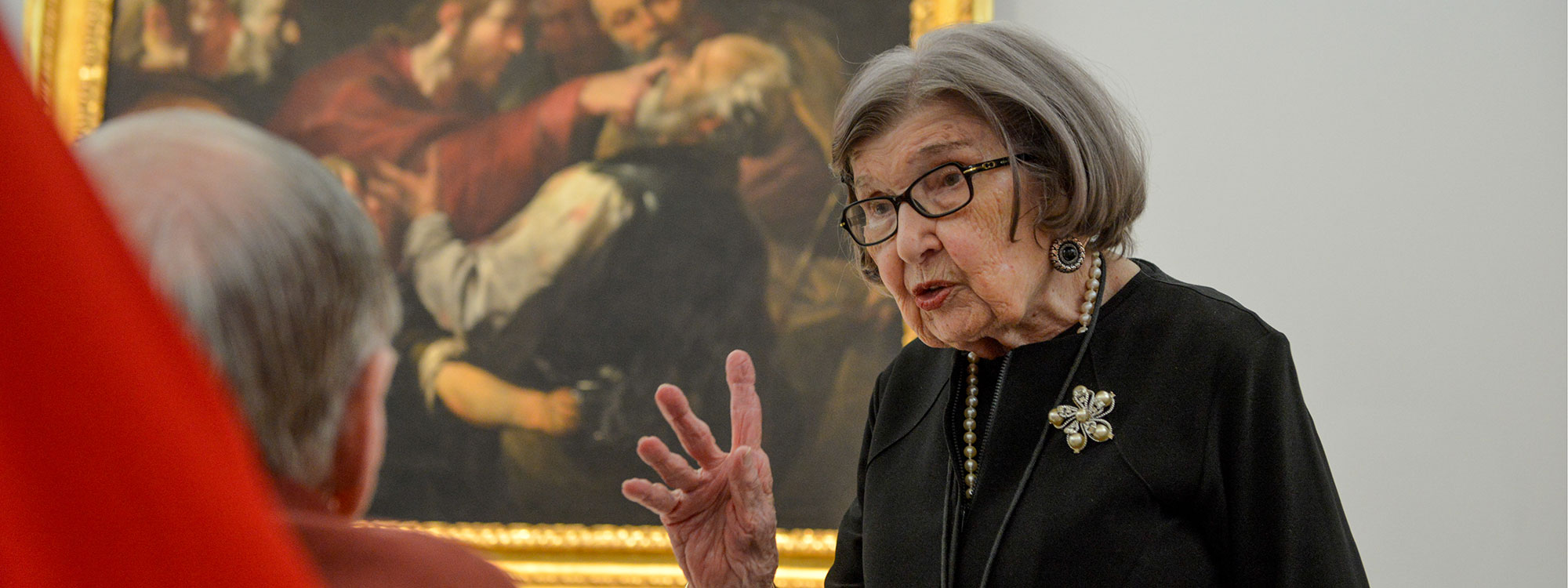They conduct explosive demonstrations that bring to life the science of forest fires, rockets, and fireworks. They connect people of all ages with art. And they help visitors try their hand at practices made famous by Andy Warhol. They toil behind the scenes, too, assisting with art and science research, data entry, and large filing projects. In 2016, 665 volunteers contributed nearly 59,000 hours across the four Carnegie Museums. An additional 500 people donated 2,000 hours during special events such as the Covestro Pittsburgh Regional Science & Engineering Fair and the National Day of Service. They’re art and science lovers, retired teachers, and medical doctors. The Miniature Railroad & Village® at Carnegie Science Center attracts volunteers with some of the most diverse career experience—currently including a retired pastor and corrections officer and a working actor—many of whom are train enthusiasts, history buffs, or both. The oldest Carnegie Museums volunteer is 91 and the youngest is 14. The longest-serving has been part of the Carnegie Museums family for a remarkable 38 years.
Martha Malinzak
Docent, Carnegie Museum of Art
21 years
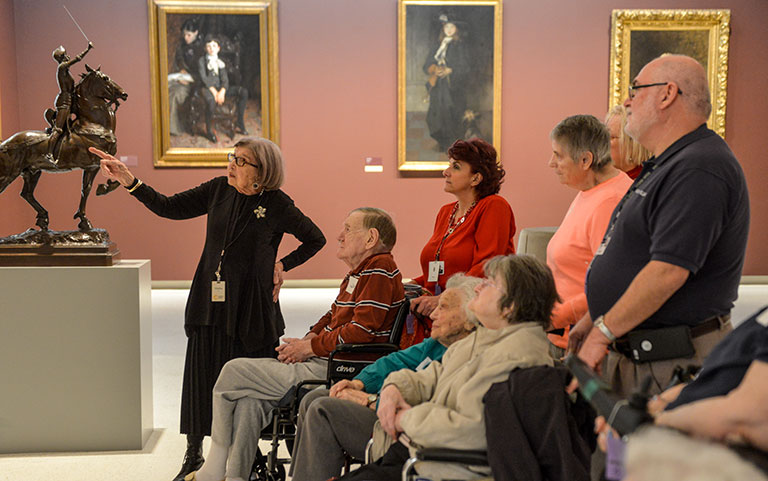
Photo: Jim Judkis
The theme of the day’s tour, Martha Malinzak tells the group, is religious history in art. “Every painting tells a story,” she says, walking from participant to participant, bending down to make eye contact with those in wheelchairs, addressing each by name. “There’s a lot to see in this painting,” she says gently, pointing to Madonna and Child Enthroned with Saints Leonard, Jerome, John the Baptist, and Francis, an early example of Renaissance art by Nicolo di Maestro Antonio d’Ancona. “What’s the first thing you notice?”
Malinzak doesn’t always get much feedback from this special group of visitors from Masonic Village at Sewickley; a few comments about the color red, the wobbly-looking knees on one of the saints, the Madonna’s halo. They’re on an “In the Moment” tour, designed for visitors with Alzheimer’s disease and other forms of dementia and their caregivers. “If you can stimulate a memory that they can speak to, it’s so gratifying,” says Malinzak, who has been volunteering as a docent at Carnegie Museum of Art since 1995, the last nine years as part of the “In the Moment” program. Last year, Malinzak and colleagues accepted an award on behalf of the museum from the Presbyterian SeniorCare Foundation for the creation of the program in collaboration with Woodside Place of Oakmont, whose residents participate in the tours on a monthly basis. “It’s amazing how art reaches people above and beyond their dementia,” says Malinzak.
A retired nurse, she left her post as associate chief of nursing education at the Veterans Affairs Pittsburgh Healthcare System in 1993. Shortly after, during a sightseeing trip to the Schönbrunn Palace in Vienna, an impressionable tour guide planted a seed. “I thought, I could do that. I love learning about art.” In an average year, Museum of Art docents give tours to about 18,000 visitors, half of them school children. “I always enjoyed working with the school kids,” she says. “Helping anyone of any age connect with art is a special experience.”
Liam Sombar
Studio Assistant, The Warhol
4 years
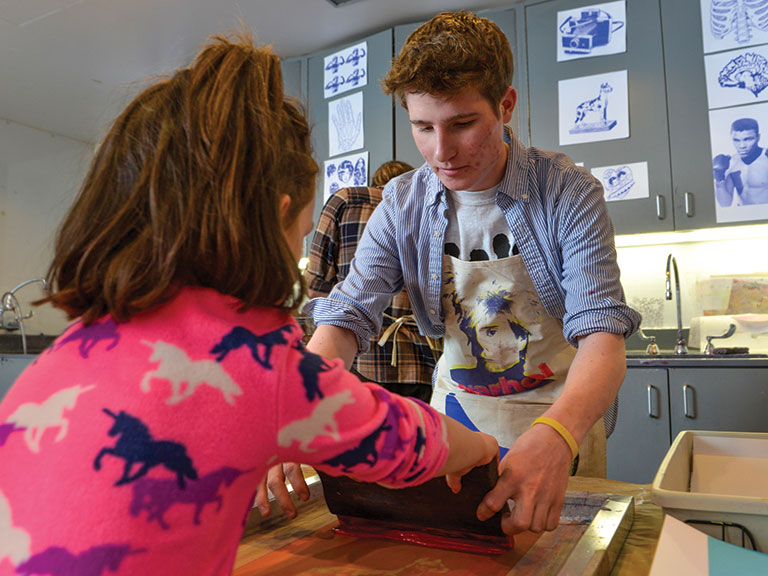
Photo: Jim Judkis
Liam Sombar was 12 when he and his mom, Judy, an artist, started regularly visiting The Andy Warhol Museum as part of his home-school curriculum. Sombar was already somewhat familiar with Warhol and his work, having chosen the Pittsburgh native as the subject of a third-grade report. “We had to pick a famous person to research,” says Sombar, now 16. “Warhol wasn’t on the list the teacher gave us, but I asked for permission to write about him.”
Sombar was drawn to the Pop artist, he says, because, like Warhol, he was interested in art from a young age and had a mom who was supportive of his art. He started regularly visiting the museum in sixth grade, spending many hours in the ground-floor studio, The Factory, where he learned how to silkscreen, a practice made famous by Warhol. Even before Sombar re-enrolled at Mt. Lebanon School District, he didn’t want to stop making art at The Warhol, so he asked if he could volunteer in the studio alongside the artist-educators. He’s been a fixture there ever since—on Saturdays during the school year and as time allows in the summers. “I enjoy every aspect of it,” says the teen, noting he’s interested in pursuing psychology and art therapy as a career. “I enjoy working with kids the most.”
What is it about Warhol’s art that inspires him? “I’m drawn to the scale and the colors,” he says, citing Warhol’s 1982 painting, Eggs, as one of his favorites. “I love the colors and the contrast against the black.”
Christina King
Theater Presenter, Carnegie Science Center
1.5 years
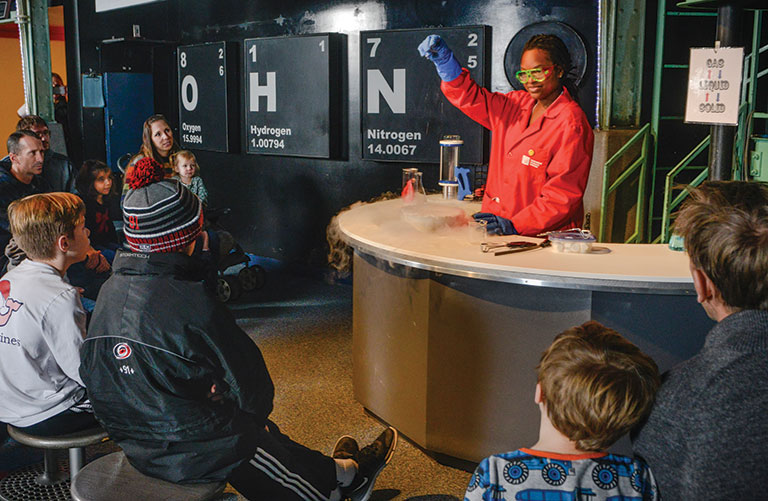
Despite carrying a heavy course load as a Ph.D. candidate in chemistry at the University of Pittsburgh, every Saturday Christina King can be found leading live science demonstrations inside Works Theater at Carnegie Science Center.
The Houston, Texas, native says she relishes the chance to make science fun and approachable—by showing off the chilling effects of super cold liquid nitrogen or the electrifying display of the one-million volt Tesla Coil—while practicing her own presentation skills. “I’m mainly trained on technical speaking, but if I’m supposed to be able to relate my science to the general community, I need to learn to speak and interact in a way that is effective,” King says. “People of all ages come to the shows, so I need to adjust to my audience. If I’m talking to a bunch of 4-year-olds, I can’t use the word threshold; they won’t understand it.”
King notes that when most people learn she’s studying chemistry, they report poor experiences with the subject in high school or college. But she knows learning about science can be an enjoyable experience, which is exactly why she thinks the work of the Science Center is so important.
“I could binge watch TV for four hours every Saturday or I can do something a little more meaningful,” she says. “It’s fun making science less of a mystery for both kids and adults.”
Melody Mendoza
Distributor, Section of Mollusks, Carnegie Museum of Natural History
9 years
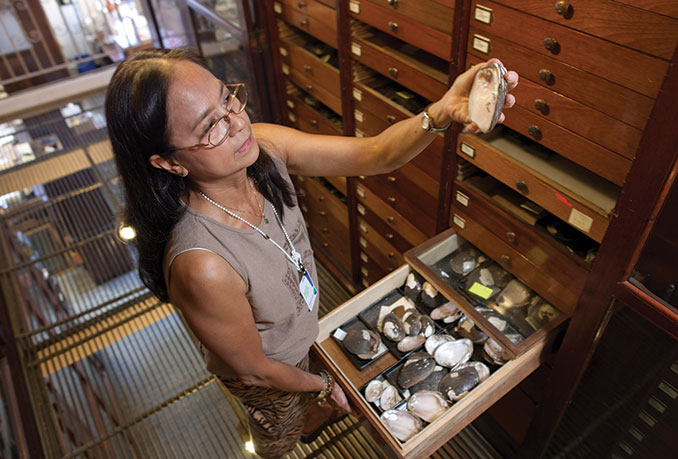
Photo: Joshua Franzos
Melody Mendoza started volunteering at Carnegie Museum of Natural History by happy accident. In 2007, she traveled to the museum on a field trip with the International Women’s Association of Pittsburgh, a social group for women from around the world living in the city, and they took a behind-the-scenes tour of the section of mollusks. Having retired a year earlier from a career in clinical chemistry, she was looking for a place to donate her time and talents, and it just so happened that she collects snail shells.
Needless to say, Mendoza was like a kid in a candy store. In addition to snails, the museum’s mollusks collection features slugs, mussels, oysters, squid, and octopus—some 1.8 million specimens in all. Having grown up in the northern Philippines, home to many rare snails, she’d been collecting the shells of both land and marine snails during her many travels around the globe. Now she could take her avocation to the next step by joining the ranks at the museum.
“I wanted to learn the family names of the snails in my garden,” says Mendoza, who moved to Pittsburgh in 1969. She’s done that, and a whole lot more: For four hours each week, she “distributes,” or files, newly catalogued specimens, placing them in the correct drawer according to family, genus, species, and catalog number.
“It’s very tedious work,” Mendoza notes, “but it’s important because the collection is used for research.” She also learns as she goes, which matters to Mendoza, who through the local women’s group also volunteers weekly at Kane Regional Center at Glen Hazel and monthly at Global Links, a global humanitarian aid organization that works to provide surplus medical supplies to those in need.
Whatever her commitments—during her career and now in retirement—the flexibility to travel and experience the world has always been a priority, whether visiting Haiti, Morocco, and Thailand, or backpacking through many of the National Parks in the United States. “I’ve always supported myself as a way to travel,” says Mendoza, “to immerse myself in a new culture”—Carnegie Museums included.
Rosemary and Lynn Haselhoff
Theater Presenters, Carnegie Science Center
2 years
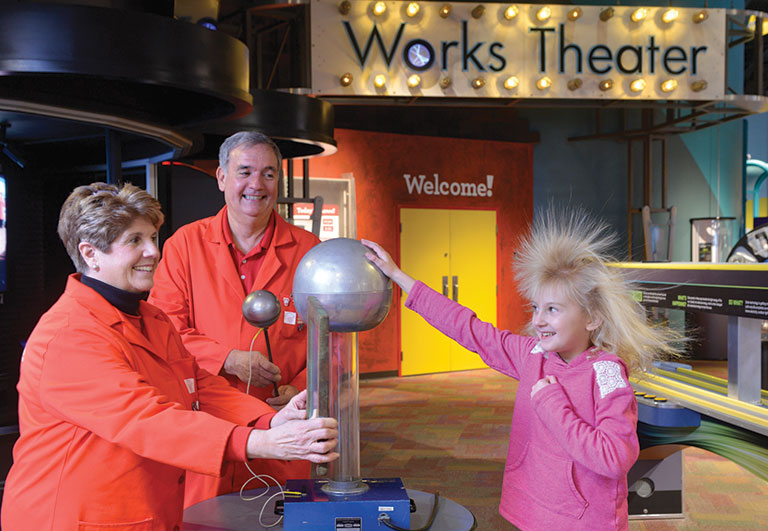
Photo: Jim Judkis
You look like a mad scientist!” Lynn Haselhoff tells their latest victim, 7-year-old Rachel Tanis, whose long blonde hair is standing on end after a shocking experience with a Van de Graff generator. Twice a week, Lynn and Rosemary Haselhoff—one of nine married couples who volunteer at Carnegie Science Center—can be found performing live science shows inside one of three demonstration theaters. Or, in the case of Rachel and the Van de Graff generator, they bring demonstrations out onto the exhibit floors.
“We love to get kids involved with hands-on science,” says Rosemary, a mathematician by training who spent 40 years working for U.S. Steel. She was one of the first women to complete the company’s management trainee program and learned all aspects of its operations, retiring as a director of human resources. Lynn, a retired electrical engineer, also worked for U.S. Steel, where the couple met, before retiring from General Electric after 30 years on the job, the last 10 installing large power plants and substations across the United States and globally.
The steel- and energy-industry retirees seem to relish the chance to be performers, even editing scripts for the science shows they regularly appear in. The duo also leads demonstrations at a host of Science Center science, technology, engineering, and math (STEM) events throughout the year, including ChemFest, SciTech Days, and Engineer the Future.
About a year ago at SciTech Days, when thousands of middle and high schoolers descend on the Science Center to learn from and about the region’s tech community, Rosemary recalls helping a group of young women extract DNA from wheat germ. A few weeks later, at a different event, one of the young women recognized her and, more importantly, remembered the science lesson. “She came up to me and said, ‘I know you. You’re a scientist. You taught me all about DNA extraction, and it was so much fun!’” Rosemary recounts. “She was beaming from ear to ear as she told her girlfriends all about it, and she was able to explain the experiment in understandable terms. If we make an impression on at least one student every time we do an event, that’s what it’s all about.”
Receive more stories in your email
Sign up
